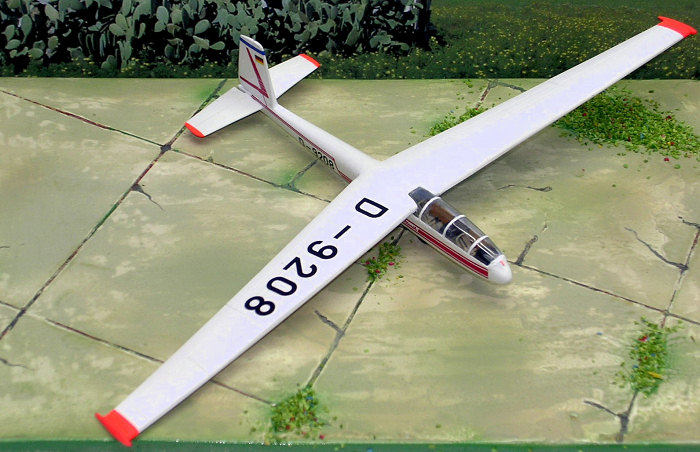
| KIT: | CMR 1/72 L-13 Blanik |
| KIT #: | ? |
| PRICE: | $? |
| DECALS: | Two options |
| REVIEWER: | Carmel J. Attard |
| NOTES: |

| HISTORY |
The Blanik is one of the oldest designs of gliders commonly
found in aero clubs all over Europe and has been regarded by many as an
excellent glider right from its early days. Apart from pleasure flights the
Blanik was also used widely by experienced pilots to i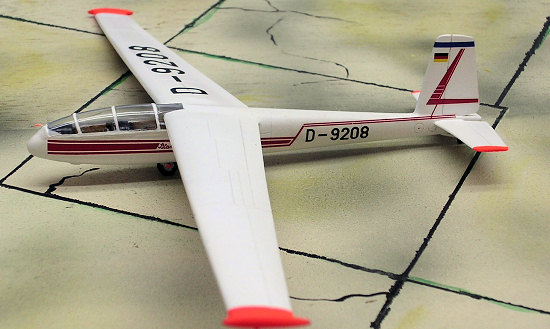 ncrease their flying
experience and qualifications. The Blanik glider is an all metal two seat glider
and having the ailerons, elevators and flaps made of fabric cover. It is of
robust construction but is a very easy glider to control, and is equipped with
instruments for flying into clouds and with oxygen equipment for high altitude
gliding of heights in the region of 8000 Metres.
ncrease their flying
experience and qualifications. The Blanik glider is an all metal two seat glider
and having the ailerons, elevators and flaps made of fabric cover. It is of
robust construction but is a very easy glider to control, and is equipped with
instruments for flying into clouds and with oxygen equipment for high altitude
gliding of heights in the region of 8000 Metres.
The Blanik has a semi-retractable landing gear, the wheel being embedded under the forward fuselage and a tail skid or a small tail wheel in later versions being fitted at the far rear. It is also equipped with point for towing from the bottom part and two points for winch take off on forward fuselage sides. The L-13 Blanik has an empty weight of 306 Kg and a maximum take off weight of 500 Kg and the minimum pilot weight of 68 Kg. It has a wing span of 16.2M, a length of 8.4M and an overall height of 2.08M., the wing area being 19.15 square metres. At 500 Kg glider weight the stall speed is 60Km/hr, the max speed for air tow is 120 Km/hr and the maximum speed is 253 Km/hr. The Blanik glider was found in abundance in many clubs all over Europe namely Czech Rep., Germany, Switzerland, among others. Some also found their way to the United States and others were used by the RAF Air Training Corps.
| THE KIT |
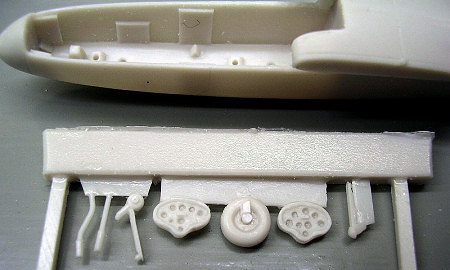 The L-13 Blanik is a glider model made to a scale of 1/72 by
Czech masters Resin and is a welcomed kit particularly by those who are keen on
gliders. The model consists of 17 resin parts and a clear vac form cockpit (a
spare one is also included). Cockpit interior is well detailed which includes
two instrument panels, two detailed seats, and two control columns for dual
control. Apart from the forward main wheel which fits inside a recess positioned
under the nose, there is a rear tiny wheel and support. This can be replaced
with a tail skid if one should prefer an earlier version. Main planes come in
two parts, port and starboard which are smooth and well reproduced with engraved
panelling and control surfaces. As these are butt jointed with the one piece
fuselage, care has to be taken to align these carefully when fitting them. Tail
planes have locating guides which makes it easier to fit in correct place. The
rudder comes as a separate part. The vac form cockpit has to be cut with a pair
of scissors and bring it to fit. This proved to be not as complex as it may
sound and I found it to be a rather straight forward job with the full benefits
that a clear vac form cockpit brings, exhibiting the carefully painted interior.
The L-13 Blanik is a glider model made to a scale of 1/72 by
Czech masters Resin and is a welcomed kit particularly by those who are keen on
gliders. The model consists of 17 resin parts and a clear vac form cockpit (a
spare one is also included). Cockpit interior is well detailed which includes
two instrument panels, two detailed seats, and two control columns for dual
control. Apart from the forward main wheel which fits inside a recess positioned
under the nose, there is a rear tiny wheel and support. This can be replaced
with a tail skid if one should prefer an earlier version. Main planes come in
two parts, port and starboard which are smooth and well reproduced with engraved
panelling and control surfaces. As these are butt jointed with the one piece
fuselage, care has to be taken to align these carefully when fitting them. Tail
planes have locating guides which makes it easier to fit in correct place. The
rudder comes as a separate part. The vac form cockpit has to be cut with a pair
of scissors and bring it to fit. This proved to be not as complex as it may
sound and I found it to be a rather straight forward job with the full benefits
that a clear vac form cockpit brings, exhibiting the carefully painted interior.
Colour options in the kit are diverse as there are four
colourschemes to choose from. Three of these are in overall aluminium finish
which includes L-13in markings of RAF Air Training Corps; this has also two
Day-Glo orange st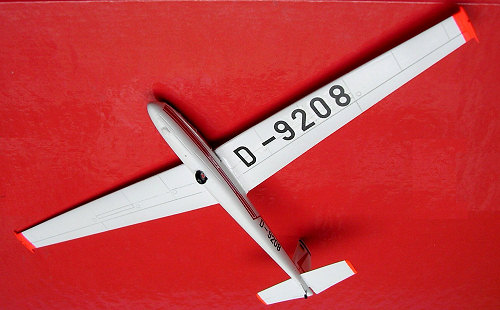 ripes across the fuselage. A separate colour drawing depicts
this scheme. Other schemes in aluminium finish include a Swiss, and an American
registered one. An all white Blanik comes in German registration which was the
one I preferred to do. Each of these has colourful decals of very good quality.
ripes across the fuselage. A separate colour drawing depicts
this scheme. Other schemes in aluminium finish include a Swiss, and an American
registered one. An all white Blanik comes in German registration which was the
one I preferred to do. Each of these has colourful decals of very good quality.
| CONSTRUCTION |
Assembly was a simple sequence, easy enough to follow the kit instructions.
| COLORS & MARKINGS |
For paintwork the
interior was light aircraft grey and seats finished in colours to ones fancy.
The kit was in the end given a semi matt white coat, this served as a good
undercoat to both the Day-Glo wing tips of main planes and tail planes. These
small areas in bright orange were then masked with Tamiya tape and the kit was
ready for the final overall semi gloss white finish. The surface was again
allowed to dry, checked for any imperfections; surfaces were subjected to a very
light wet and dry sanding and
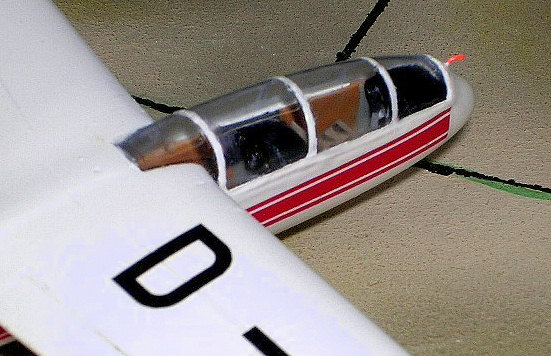 again given the final coat
of gloss white using Hambrol paint. The kit was given 24 hours to dry and was
then ready to fix the decal which I chose to do a German registered one
D-9208.All the other markings on the kit were the set of decals supplied.
again given the final coat
of gloss white using Hambrol paint. The kit was given 24 hours to dry and was
then ready to fix the decal which I chose to do a German registered one
D-9208.All the other markings on the kit were the set of decals supplied.
| CONCLUSIONS |
This kit certainly appeals to the glider fans in particular but the way I see it is that no collection is complete without a glider present among the kits and here is the chance to add a really authentic and popular glider kit which is that of the popular Blanik.
May 2007
If you would like your product reviewed fairly and quickly by a site that has nearly 350,000 visitors a month, please contact me or see other details in the Note to Contributors.